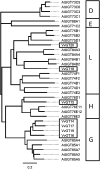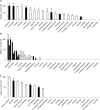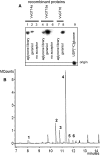Activity-based profiling of a physiologic aglycone library reveals sugar acceptor promiscuity of family 1 UDP-glucosyltransferases from grape
- PMID: 25073706
- PMCID: PMC4149709
- DOI: 10.1104/pp.114.242578
Activity-based profiling of a physiologic aglycone library reveals sugar acceptor promiscuity of family 1 UDP-glucosyltransferases from grape
Abstract
Monoterpenols serve various biological functions and accumulate in grape (Vitis vinifera), where a major fraction occurs as nonvolatile glycosides. We have screened the grape genome for sequences with similarity to terpene URIDINE DIPHOSPHATE GLYCOSYLTRANSFERASES (UGTs) from Arabidopsis (Arabidopsis thaliana). A ripening-related expression pattern was shown for three candidates by spatial and temporal expression analyses in five grape cultivars. Transcript accumulation correlated with the production of monoterpenyl β-d-glucosides in grape exocarp during ripening and was low in vegetative tissue. Targeted functional screening of the recombinant UGTs for their biological substrates was performed by activity-based metabolite profiling (ABMP) employing a physiologic library of aglycones built from glycosides isolated from grape. This approach led to the identification of two UDP-glucose:monoterpenol β-d-glucosyltransferases. Whereas VvGT14a glucosylated geraniol, R,S-citronellol, and nerol with similar efficiency, the three allelic forms VvGT15a, VvGT15b, and VvGT15c preferred geraniol over nerol. Kinetic resolution of R,S-citronellol and R,S-linalool was shown for VvGT15a and VvGT14a, respectively. ABMP revealed geraniol as the major biological substrate but also disclosed that these UGTs may add to the production of further glycoconjugates in planta. ABMP of aglycone libraries provides a versatile tool to uncover novel biologically relevant substrates of small-molecule glycosyltransferases that often show broad sugar acceptor promiscuity.
© 2014 American Society of Plant Biologists. All Rights Reserved.
Figures









References
-
- Bowles D, Lim EK, Poppenberger B, Vaistij FE. (2006) Glycosyltransferases of lipophilic small molecules. Annu Rev Plant Biol 57: 567–597 - PubMed
-
- Caputi L, Lim EK, Bowles DJ. (2008) Discovery of new biocatalysts for the glycosylation of terpenoid scaffolds. Chemistry 14: 6656–6662 - PubMed
-
- Caputi L, Lim EK, Bowles DJ (June 10, 2010) Monoterpenoid modifying enzymes. US Patent Application No. US2010/0143975
-
- Caputi L, Malnoy M, Goremykin V, Nikiforova S, Martens S. (2012) A genome-wide phylogenetic reconstruction of family 1 UDP-glycosyltransferases revealed the expansion of the family during the adaptation of plants to life on land. Plant J 69: 1030–1042 - PubMed
Publication types
MeSH terms
Substances
LinkOut - more resources
Full Text Sources
Other Literature Sources

